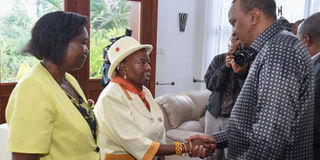Uhuru still has a chance to salvage his legacy through transformative agenda

President Uhuru Kenyatta consoles the mother of the late former Nairobi Mayor Dick Waithika at his Nairobi home. As we enter 2016, President Kenyatta’s honeymoon for experimenting with big projects has narrowed drastically. PHOTO | NATION MEDIA GROUP
What you need to know:
- First, Mr Kibaki managed within two years of his administration to bring interest rates down.
- From my own observations and interviews with officials of the China Roads and Bridge Company, I believe that Jubilee will deliver this project before its term ends.
- I believe that if we had the Government Investment Corporation the task force had recommended, we would know where we are going with Kenya Airways, Mumias Sugar Company, or even Panpaper.
Where and when did we lose the growth momentum of the Mwai Kibaki years?
This is the question which must be on President Uhuru Kenyatta’s mind as the New Year approaches.
By the time Mr Kibaki was in his third year, the economy had registered spectacular growth.
So, what trick did Mr Kibaki have that President Kenyatta has not yet discovered?
What did Mr Kibaki have that his successor does not have?
At the risk of engaging in oversimplification, the differences between the two regimes are as follows:
First, Mr Kibaki managed within two years of his administration to bring interest rates down.
I still remember how the Treasury bill rate fell to 1 per cent and how commercial banks were forced to start lending to small businesses and giving personal loans.
This amounted to capital injection into the economy.
Secondly, Mr Kibaki had by his third year in office kicked up an infrastructure boom by increasing the budget for roads, ports, airports, and electricity by huge margins — and by within months of his taking office rolling out free primary education,
Perhaps even more significantly, Mr Kibaki’s Cabinet and administration had the power, means, and capacity to successfully implement the government’s policies and programmes.
Let us now examine how President Kenyatta has performed in the first three years of his administration.
I think the biggest weakness of his administration has been low capacity to implement big projects and ideas.
STALLED PROJECTS
I will be the first to accept that President Kenyatta’s personal intervention has been instrumental in keeping the standard gauge railway project on track.
From my own observations and interviews with officials of the China Roads and Bridge Company, I believe that Jubilee will deliver this project before its term ends.
Otherwise, there is a long list of big ideas and projects that have more or less stalled.
The laptops project fell victim to the exploits and games of well-connected tenderprenuers.
The million-acre Galana project, the Jubilee administration’s flagship project to deliver food security and minimise Kenya’s reliance on rain-fed agriculture, is suffocating in the hands of the rent-seeking elite.
The 10,000 kilometre roads project under the annuity model has come a cropper.
We have been taken through a big lesson in the merits and demerits of copying and pasting, of assuming that what works in India will work in Kenya.
Konza — our Silicon Savannah — has not moved any significant distance from where Mr Kibaki left it.
With the 5,000MW electricity project, most of what you see are projects started by the Kibaki administration.
Then you have the Lamu Port Southern Sudan-Ethiopia Transport (Lapsset) Corridor project.
We all remember how Mr Kibaki hurriedly mobilised regional leaders to join him in breaking the ground for the big project.
Indeed, Mr Kibaki, through a presidential decree, created a fully-fledged parastatal to run Lapsset.
Although a contractor for the first three berths of the Lamu port is in place, not much has happened, mainly because of budgetary issues.
Save for the building of the headquarters, which has gobbled up billions, the process of procuring international investors to undertake the remaining public-private partnership projects, as conceived in the initiative, has not made any tangible progress.
UHURU'S FINAL LAP
I will now turn to President Kenyatta’s transformation agenda, which he kicked off by appointing a blue ribbon parastatal reform task force that came up with excellent ideas and recommendations.
I believe that if we had the Government Investment Corporation the task force had recommended, we would know where we are going with Kenya Airways, Mumias Sugar Company, or even Panpaper.
We would have had a sovereign wealth fund in place.
The reforms have more or less stalled because of resistance by the National Treasury.
As we enter 2016, President Kenyatta’s honeymoon for experimenting with big projects has narrowed drastically.
He must more sharply define what he must do in the remaining period of his term by carefully limiting the reach of what he wants to deliver.
The ambitious transformative agenda he put together is his best chance at a strong legacy.
How he manages to push these ideas through to implementation will be his biggest challenge in the coming months.





